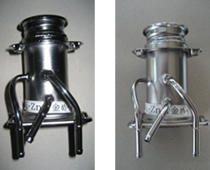It is widely known that preferable sacrificial anti-corrosive zinc-based plating films for iron, cast iron, and other iron-based materials have a natural potential close to iron though it is less noble than iron. From these perspectives, zinc-nickel alloy plating and zinc-iron alloy plating having excellent anticorrosion property with the potential of zinc controlled by alloying nickel and iron have been commercialized.
| Type of plating | Features | SST white rust | SST red rust |
|---|---|---|---|
| Zn-Fe alloy plating | Colored chromate | 120 H | 800 H |
| Sn-Zn alloy plating | Colored chromate | 192 H | 800 H |
| Zn-Ni alloy plating (containing 7 – 10% Ni) |
Hexavalent colored chromate | 600 H | 1200 H |
Trivalent colored chromate
|
500 H | 1500 H | |
| Zn-Ni alloy plating (containing 10 – 15% Ni) |
Trivalent colored chromate |
1200 H | 3000 H |

Zinc-nickel alloy plating
(left: trivalent black) (right: trivalent colored)
Types of plating
Materials & uses